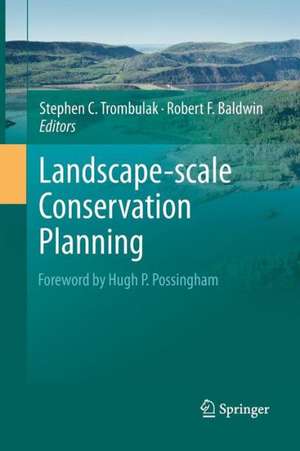Landscape-scale Conservation Planning
Editat de Stephen C. Trombulak, Robert Baldwinen Limba Engleză Paperback – 17 oct 2014
| Toate formatele și edițiile | Preț | Express |
|---|---|---|
| Paperback (1) | 1387.10 lei 6-8 săpt. | |
| SPRINGER NETHERLANDS – 17 oct 2014 | 1387.10 lei 6-8 săpt. | |
| Hardback (1) | 1393.27 lei 6-8 săpt. | |
| SPRINGER NETHERLANDS – 22 sep 2010 | 1393.27 lei 6-8 săpt. |
Preț: 1387.10 lei
Preț vechi: 1691.59 lei
-18% Nou
Puncte Express: 2081
Preț estimativ în valută:
265.51€ • 288.50$ • 223.17£
265.51€ • 288.50$ • 223.17£
Carte tipărită la comandă
Livrare economică 21 aprilie-05 mai
Preluare comenzi: 021 569.72.76
Specificații
ISBN-13: 9789401784634
ISBN-10: 9401784639
Pagini: 444
Ilustrații: XIII, 427 p.
Dimensiuni: 155 x 235 x 23 mm
Greutate: 0.62 kg
Ediția:2010
Editura: SPRINGER NETHERLANDS
Colecția Springer
Locul publicării:Dordrecht, Netherlands
ISBN-10: 9401784639
Pagini: 444
Ilustrații: XIII, 427 p.
Dimensiuni: 155 x 235 x 23 mm
Greutate: 0.62 kg
Ediția:2010
Editura: SPRINGER NETHERLANDS
Colecția Springer
Locul publicării:Dordrecht, Netherlands
Public țintă
Professional/practitionerCuprins
Introduction: Creating a Context for Landscape-Scale Conservation Planning.- Identifying Keystone Threats to Biological Diversity.- Why History Matters in Conservation Planning.- Developing Institutions to Overcome Governance Barriers to Ecoregional Conservation.- Changing Socio-economic Conditions for Private Woodland Protection.- Aquatic Conservation Planning at a Landscape Scale.- From the Last of the Large to the Remnants of the Rare: Bird Conservation at an Ecoregional Scale.- The Transboundary Nature of Seabird Ecology.- Conservation Planning with Large Carnivores and Ungulates in Eastern North America: Learning from the Past to Plan for the Future.- Protecting Natural Resources on Private Lands: The Role of Collaboration in Land-Use Planning.- Integrating Expert Judgment into Systematic Ecoregional Conservation Planning.- The GIS Challenges of Ecoregional Conservation Planning.- The Human Footprint as a Conservation Planning Tool.- Assessing Irreplaceability for Systematic Conservation Planning.- Conservation Planning in a Changing Climate: Assessing the Impacts of Potential Range Shifts on a Reserve Network.- Modeling Ecoregional Connectivity.- A General Model for Site-Based Conservation in Human-Dominated Landscapes: The Landscape Species Approach.- Integrating Ecoregional Planning at Greater Spatial Scales.
Textul de pe ultima copertă
This book expands the thinking and techniques of the new field of systematic conservation planning to include significant improvements borne of integrating social and natural conditions and processes to address the questions and problems of protecting ecosystem pattern and process in human-dominated landscapes. Specifically it undertakes to answer the question of how to accomplish ecoregion-scale, transboundary conservation in a variety of realms including seascapes, multiple nations and jurisdictions, all by using numerous conservation targets and by incorporating changing climate, land use, and other social and natural processes operating at multi-spatial and temporal scales.
Caracteristici
Ecoregional, transboundary approach with interdisciplinary and international appeal Integrates social and natural sciences with cutting edge conservation planning technologies Provides case studies of actual conservation planning projects Relevant to real world problem solving by complementing more technical, how-to books recently published on conservation planning Includes supplementary material: sn.pub/extras











